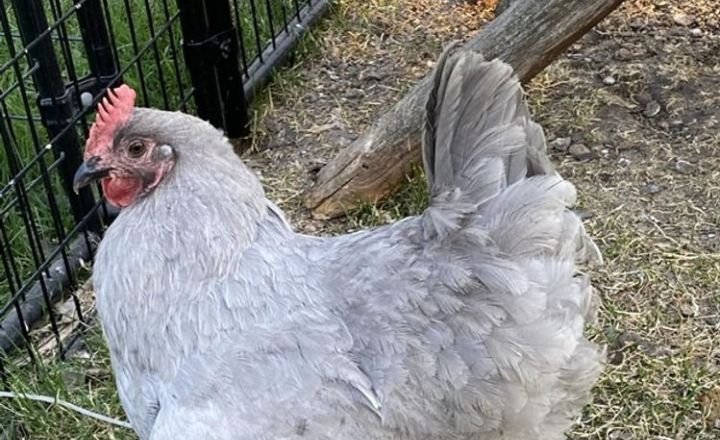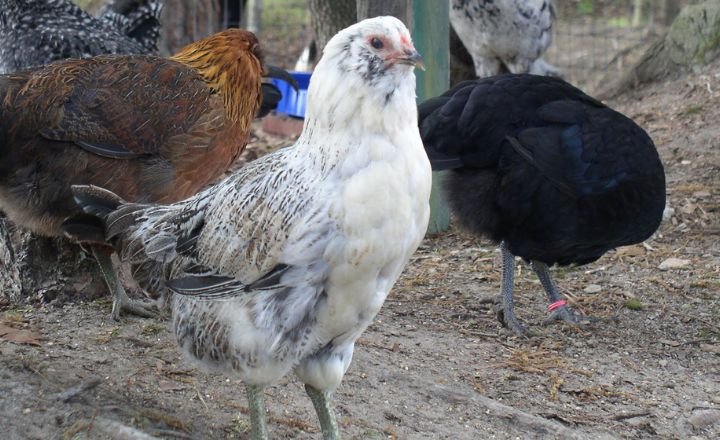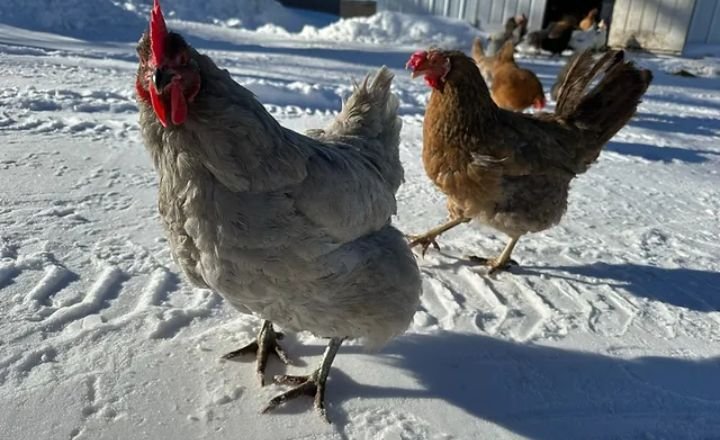A splash of color and personality to your backyard flock, the Ameraucana chicken might be the perfect fit. Their stunning blue eggs and vibrant plumage, these birds are more than just eye candy.
They bring a unique charm that has captivated poultry enthusiasts for generations. But what does it take to ensure your Ameraucanas thrive in your care in the ultimate guide, we’ll delve into everything you need to know about raising these delightful chickens, from their dietary needs and housing preferences to tips on keeping them healthy and happy.
Who Doesn’t Love A Fluffy Purple Chicken That Lays Blue Eggs?
There’s something undeniably charming about watching my frizzled Lavender Ameraucanas trundle around the yard, their unique feathering resembling soft, curly clouds that dance in the sunlight.
These birds possess a delightful curiosity that draws you in, making each encounter feel like an adventurous exploration. It’s easy to get lost in their fabulous plumage and unusual coloration, like a lavender sunset. Their gentle temperament truly captivates me.

They’re not just birds. They’re personalities with feathers, eager to interact and explore the world around them.A is particularly fascinating about these Ameraucanas is how genetic variations can yield such diverse appearances while maintaining that signature-loving disposition.
A specific gene causes the fluffy texture of frizzled feathers, but even those without this particular trait still exude a vibrant joyfulness that’s hard to overlook.
What Is An Ameraucana Chicken, and Where Did It Come From?
Delving into the world of these fascinating birds reveals that the distinctions between Ameraucanas, Araucanas, and Easter Eggers can spark lively debates among poultry enthusiasts. Some argue that Ameraucanas are direct descendants of Araucanas. Others highlight their unique breeding goals to enhance traits like muffs and beards.

This divergence not only showcases the creativity in avian breeding but also reflects a commitment to preserving distinct characteristics within chicken breeds while continuing to celebrate their rich histories.
The charm of these birds isn’t just in their striking appearances or extraordinary egg colors; it’s also found in their personalities and behaviors. Arriving with various comb types and plumage patterns, both Ameraucanas and Araucanas possess an engaging morphology that draws breeders and hobbyists alike.
A enthusiasts ponder the implications of selective breeding on traits like rumplessness or tufted features, Easter Eggers emerge as delightful wildcards—capturing hearts with their unexpected appearance blends and the promise of colorful eggs.
Why Does One Keep Ameraucana Chickens?
The Ameraucana chicken is a beautiful bird to watch in your backyard. Its vibrant presence adds charm and character to your flock. Their striking plumage, which can range from black to blue or wheaten, offers an aesthetic appeal that goes beyond mere egg-laying.
A truly sets them apart is their gentle demeanor. These friendly birds get along well with other chickens and even enjoy human interaction, making them a delightful addition to families seeking companionship in their poultry.
Egg production of approximately 200-250 stunning pastel blue eggs each year is impressive enough to attract any chicken enthusiast. It’s the uniqueness of the color that captures admiration. Each Ameraucana egg boasts a consistent hue throughout its shell, providing not only beauty but also variety in shades for your breakfast table.
Are Blue Eggs Better For Me?
The allure of blue eggs often leads consumers to believe they carry unique health benefits, but the truth is far more straightforward and more grounded in biology. The vibrant hue comes from a natural pigment called oocyanin, which seeps into the egg’s shell while forming inside the hen.
This striking color variation has captured the imagination of many, yet it carries no particular nutritional advantage over white or brown eggs. All chicken eggs share a similar composition, regardless of shell color.
Interestingly, this misconception highlights a broader trend in how we perceive food. They often view aesthetics as indicative of quality or value. When choosing eggs, it’s essential to look beyond an appealing exterior and consider factors like freshness and sourcing.
Nutritional content remains broadly consistent across different types; therefore, whether you crack open a classic white egg or one adorned with a bluish tint, you’re getting protein-rich nourishment that’s fundamentally equivalent.
Temperament
There’s something genuinely endearing about Ameraucanas that makes interactions with them feel more like a friendship than a typical pet-owner dynamic. Their spirited curiosity and sweet disposition shine through even as chicks, making them delightful companions right from the start.
I often find myself chuckling as my big fluffy rooster becomes my shadow. He insists on being picked up, not for long, a quick turnaround speaks volumes about his playful nature, reminding me to cherish these moments of affection amidst our lively daily routine.
These birds thrive in an environment where they can express their energetic personalities. Watching them dash around the yard, chasing insects or engaging in playful banter with each other offers endless entertainment; it’s nature’s reality show right outside the door. They are generally confident and not easily spooked. Their instinct to flee can catch you off guard if they sense danger, which is just one of those nuances that come with caring for such spirited creatures.
A provided ample space and companionship with similarly sized hens, Ameraucanas showcase their genial spirits beautifully, turning any coop into a bustling community filled with laughter and lighthearted antics.
Housing
Ensuring that poultry live in clean, spacious environments fosters their health and enhances the joy of keeping them. A well-maintained hen house or barn is a fortress against nocturnal predators, allowing birds to rest peacefully at night without stress or fear.
The importance of daily cleaning cannot be overstated it prevents disease and creates an atmosphere in which hens can express their natural behaviors freely.
Hens are remarkably sociable creatures; they thrive on companionship, often forming delightful cliques among themselves. It’s fascinating how they’re drawn to share a cozy space, even with several nesting boxes available.
This communal nesting behavior may feel like an endearing quirk, but it indicates their social nature and comfort with one another. Adequate roosting options encourage harmony among the flock, as hens can perch together and bond before settling down for the night.
Many simply prefer to leap effortlessly onto roosting bars from the ground below, while others appreciate a ramp for easier access.
Weather Tolerance
Creating a comfortable environment for your Ameraucanas in extreme weather conditions isn’t just about shelter but ingenuity and proactive planning. In scorching heat, shade becomes critical.
Consider planting sunflowers or setting up tarps to create natural canopies that shield your birds and enhance the aesthetics of your backyard coop. Water accessibility is equally vital; elevated troughs prevent contamination while allowing those delightful beard wattles to stay dry and clean.

A winter strikes, the focus shifts towards insulation and protection from chilling winds. Implementing windbreaks can be as simple as stacking hay bales or strategically placing plywood around the coop, providing a barrier against biting gusts without sacrificing air circulation.
Breathing condenses to create moisture that can quickly lead to respiratory issues, an unseen enemy lurking in frosty environments. The key lies in finding that balance: ensuring plenty of fresh air while keeping drafts at bay will help keep their spirits high when temperatures plummet.
Elevating your management techniques during these temperature extremes fosters healthier birds and enriches the experience of raising such fascinating creatures as Ameraucana chickens.
Diet
Free-ranging provides our feathered friends with the thrill of foraging. The foundation of their diet must be rooted in high-quality chicken feed. Unlike scratch grains, which are a delightful treat, poultry-specific pellets or crumbles are designed to meet all nutritional needs.
These feeds are formulated to deliver essential protein, vitamins, and minerals that support optimal health and robust egg production. A thrive on balanced meals rather than snacking throughout the day, and do our birds.
Incorporating free-choice grit becomes crucial for those with limited outdoor access to their flock. This gritty addition aids digestion, allowing birds to break down the food they consume effectively.
Calcium supplements such as crushed oyster shells can benefit laying hens by promoting stronger eggshells and healthier layers. And let’s not overlook water. Ensuring fresh, clean water is available encourages hydration. After all, even critters must stay refreshed amidst all their pecking adventures.
Where to Purchase?
A embarking on your journey to find the perfect Ameraucana, it is imperative to dive deep into the details rather than rushing through the process. The nuanced spelling of Ameraucana versus various misspellings like Ameracana or Americauna isn’t just a trivial detail it speaks volumes about the breeder’s knowledge and commitment to quality.
A discerning buyer must ask probing questions and carefully analyze descriptions to ensure they get what they truly want and avoid mistakenly acquiring an Easter Egger instead.
The potential is a priority for you. Prioritizing breeders who breed to meet the American Poultry Association’s Standard of Perfection is vital. These passionate individuals will not only help you understand what constitutes quality stock but can also provide invaluable insights into their breeding programs.
They often possess award-winning birds, and yes, this expertise comes at a price, be prepared for costs starting around $10 per chick from these reputable sources.
Contrast that with hobbyists who might sell chicks as low as $6; while affordable, these birds may not carry the pedigree or genetic assurance one requires for severe breeding or showing ambitions.
Summary
Caring for Ameraucana chickens can be a rewarding experience for novice and seasoned poultry enthusiasts. By understanding their unique diet, housing, and healthcare needs, you can ensure these beautiful birds thrive in your backyard.
Their friendly temperament and distinctive blue eggs make them a delightful addition to any flock. An informed about potential challenges and remain proactive in maintaining their well-being.
